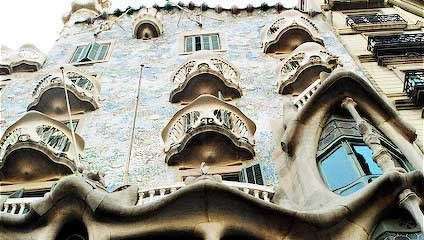Eiffel Tower
The Eiffel Tower is a wrought iron lattice tower on the Champ de Mars in Paris, France, is the most-visited paid monument in the world, named after the engineer Gustave Eiffel, whose company designed and built the tower.
The puddle-iron structure is composed of four immense arched legs, set on masonry piers that curve inward until joining in a single, tapered tower.
Constructed from 1887–89 as the entrance to the 1889 World’s Fair, it was initially criticised by some of leading artists and intellectuals for its design, but it has become a global cultural icon of France and one of the most recognisable structures in the world.
The tower is 324 metres (1,063 ft) tall, about the same height as an 81-storey building, and the tallest structure in Paris. Its base is square, measuring 125 metres (410 ft) on each side.
The tower has three levels for visitors, with restaurants on the first and second levels.
The French name for the Eiffel Tower is La Tour Eiffel, it also has the nickname La Dame de Fer (“The Iron Lady”).
| General information | |
|---|---|
| Type | Observation tower Broadcasting tower |
| Construction started | 28 January 1887 |
| Completed | 15 March 1889 |
| Opening | 31 March 1889 |
| Owner | City of Paris, France |
| Management | Société d’Exploitation de la Tour Eiffel (SETE) |
| Height | |
| Architectural | 300 m (984 ft) |
| Tip | 324 m (1,063 ft) |
| Top floor | 276 m (906 ft) |
| Technical details | |
| Floor count | 3 |
| Lifts/elevators | 8 |
| Design and construction | |
| Architect | Stephen Sauvestre |
| Structural engineer | Maurice Koechlin Émile Nouguier |
| Main contractor | Compagnie des Etablissements Eiffel |
The Eiffel Tower was built for the 1889 Paris Exposition and was not intended to be permanent.
It took 2 years, 2 months and 5 days to complete the assembly which is a true testament to French engineering at the time.
The Eiffel Tower’s construction took around 300 workers to assemble the 18,038 pieces of wrought iron and 2.5 million rivets.
Each of the 18,000 pieces used to build the tower was calculated specifically for the project and prepared in Eiffel’s factory on the outskirts of Paris. All of the pieces are held in place with rivets each needing a four-man team to install. One heated it up, another held it in place, a third shaped the head and the fourth beat it with a sledgehammer.
Building the tower required 2.5 million thermally assembled rivets and 7,300 tons of iron. To protect the tower from the elements, workers painted every inch of the structure, a feat that required 60 tons of paint. The tower gets painted every 7 years.
The puddled iron (wrought iron) of the Eiffel Tower weighs 7,300 tons, and the addition of lifts, shops and antennae have brought the total weight to approximately 10,100 tons.
Visitors can climb up stairs to the first two levels or take a lift which also has access to the third and highest level – 1,665 steps are needed to climb all the way to the top of the Eiffel Tower.
The Eiffel Tower was the tallest man made structure in the world for 41 years until the completion of the Chrysler Building in New York in 1930.
The Eiffel Tower was designed to sway slightly in the wind, but the sun affects the tower more. As the sun-facing side of the tower heats up, the top moves as much as 7 inches (18 centimeters) away from the sun. Temperature also alters the height of the Eiffel Tower by up to 6 inches (15 centimetres).
Gustave Eiffel engraved on the tower the names of 72 French scientists, engineers and mathematicians in recognition of their contributions to the building of the tower. Eiffel chose this “invocation of science” because of his concern over the artists’ protest. At the beginning of the 20th century, the engravings were painted over, but they were restored in 1986–87 by the Société Nouvelle d’exploitation de la Tour Eiffel, a company operating the tower.
Maintenance of the tower includes applying 60 tons of paint every seven years to prevent it from rusting.
The Eiffel Tower was going to be demolished in 1909, but was saved because it was repurposed as a giant radio antenna.
In 1960 Charles de Gaulle proposed temporarily dismantling the tower and sending it to Montreal for Expo 67. The plan was rejected.
Gustave Eiffel kept a small apartment on the third floor for entertaining friends. It is now open to the public. He also designed interior elements of the Statue of Liberty. He died while listening to Beethoven’s 5th symphony.















